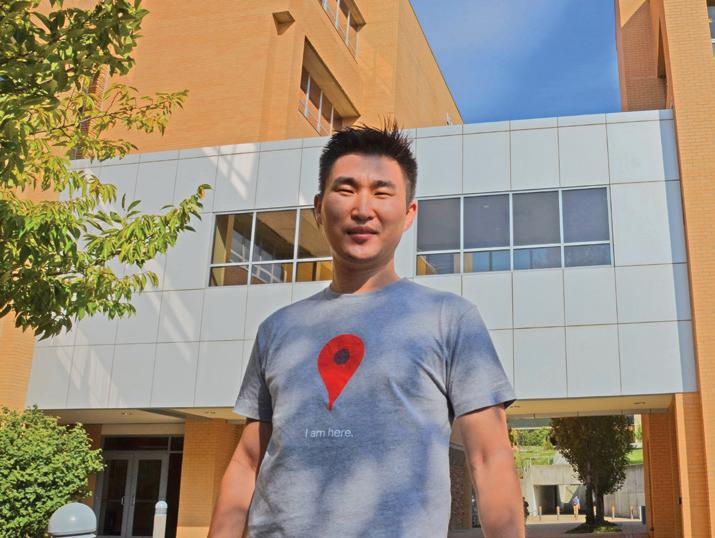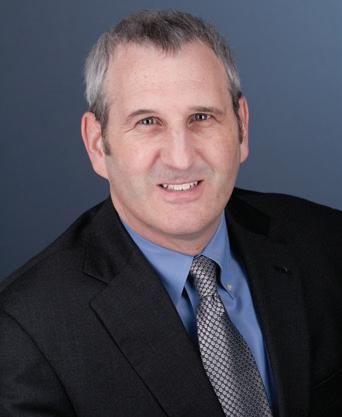
6 minute read
Five KU Researchers Earn Career Awards from the National Science Foundation
by Joel Mathis
Five assistant professors from the KU School of Engineering each received a prestigious grant designed to help early-career faculty members in STEM disciplines establish a lifetime of leadership in their respective fields.
Advertisement
The National Science Foundation CAREER grants were awarded to Esam El-Araby, assistant professor of electrical engineering and computer science; Gibum Kwon, assistant professor of mechanical engineering; Xianglin Li, assistant professor of mechanical engineering; Huixuan Wu, assistant professor of aerospace engineering; and Cuncong Zhong, assistant professor of electrical engineering and computer science. Two faculty members from KU’s College of Liberal Arts and Sciences, Chris Rogan and Emily Witt, also received the awards.
“This recognition forecasts great promise for these KU faculty who represent the future of their fields and are already making discoveries and innovations that will help us understand and change our world for the better,” said Simon Atkinson, vice chancellor for research. “They join 49 previous CAREER award winners across the Lawrence campus—a number that speaks to the sustained strength of KU’s research community.”
The five-year awards are designed to support “earlycareer faculty who have the potential to serve as academic role models in research and education and to lead advances in the mission of their department or organization,” according to NSF.
Dean of Engineering Arvin Agah said the awards serve as a source of pride for the university.
“This is a tremendous accomplishment for these faculty members and shows the potential for their research to benefit society,” Agah said. “It positions them as role models for other early-career faculty and sets them on a course to be leaders throughout their academic careers. This type of recognition elevates the stature of KU Engineering and is a great example of the world-class research and teaching conducted at the University of Kansas.”
The NSF first issued CAREER awards in 1995. Since then, 56 faculty members on KU’s Lawrence campus have received the grants: 21 in the School of Engineering, two in the School of Pharmacy and 33 in schools and departments across the College of Liberal Arts & Sciences.
A LOOK AT THE FIVE 2020 RECIPIENTS FROM ENGINEERING AND THEIR RESEARCH
Esam El-Araby ESAM EL-ARABY El-Araby joined the Department of Electrical Engineering & Computer Science in 2015. He was awarded $550,351 from the NSF for his work in trying to make supercomputers more accessible to the scientists, engineers, mathematicians and other researchers who need to harness their data-processing power. His work involves “very large machines” that possess “extreme heterogeneity.” They feature multiple types of processors — CPUs, FPGAs, GPUs and more — cooperating to tackle complex problems. Such machines are used in quantum simulations, high-energy physics, oil tracking, weather forecasts and even disease modeling. “Collaboratively they can do a better job than a system just made up of CPUs, just made up of FPGAs, just made up of GPUs, made up of just one type of computing technology,” El-Araby said. Programming these machines is also a complex job, however. El-Araby’s aim is to make it easier for users to ignore those “under the hood” complexities so they can simply and quickly write applications that help them pursue their research and solve problems. “We’re trying to hide these details from the nonspecialists,” he said. Otherwise, “this is a huge challenge that could limit our national ability and international competitiveness to build and efficiently use these large and heterogeneous machines.”
Gibum Kwon GIBUM KWON Kwon, who joined the Department of Mechanical Engineering in 2016, was awarded $549,996 by NSF. His research involves investigating and establishing new technology to enable the separation of miscible liquid mixtures by selective sorption. Separation of miscible liquids is a critical step for a wide range of practical processes that include wastewater remediation, biofuel production, water purification and removal of contaminants from groundwater. Current methods of liquid separation, such as distillation and pervaporation, are often limited by consuming great amounts of energy, Kwon said. The technology he seeks “is like a sponge — if you can imagine a sponge that absorbs lots of water but at the same time repels other liquids, like oil.” “Such absorbents will surpass the technologies currently utilized in a variety of applications including environmental, biomedical and pharmaceutical engineering,” Kwon said in his submission to the NSF. “Thus, the outcomes of this research also have the potential to advance national health and prosperity.” The grant will fund more than research: Kwon also plans to develop a STEM course module for students with special needs in collaboration with KU’s Department of Special Education.
Xianglin Li
Huixuan Wu
Cuncong Zhong XIANGLIN LI Li joined the mechanical engineering department in 2014. He received an award of $500,000 for research into new battery storage technologies. “Everybody is looking for better batteries,” he said. “We’re tired of charging the cellphone every day. If we can develop batteries with higher capacity, maybe we can charge it once a week.” The current generation of cutting-edge lithium-ion batteries “is reaching its theoretical energy density limit,” Li wrote in his submission to the NSF, but “other technologies such as lithium-air battery, fuel cells and supercapacitors have great potential as the next-generation energy storage and energy conversion technologies.” The problem with current lithium-air batteries, he said, is that they can store a lot of power but they can’t transmit it at very high rates — his research will use advanced imaging and computational techniques to investigate how to improve that performance. The results should be environmentally friendly, Li said, among other benefits. “A smaller battery is typically cheaper,” he said. “If the battery that can drive the car for 300 miles is reduced to one-tenth the size, it will be much cheaper.”
HUIXUAN WU Wu, who joined the Department of Aerospace Engineering in 2015, was awarded $500,000 to peek into the often opaque heart of “complex particulate flows” to understand the internal mechanics of fluid matter in motion. Observers can see what’s happening on the surface of a muddy, dirty river, Wu said, but there are many important things happening beneath the surface and unavailable to the naked eye. “If you want to imagine the motion of a muddy, dirty river, you have to see through it,” he said. Wu plans to develop a magnetic-based measure of liquid motion so scientists don’t have to rely on visuals to understand how they work. “From a scientific point of view, there are a lot of motions in the universe that people have been able to study only because they see them,” Wu said. His research, he said, could lead to technologies that help scientists better predict everything from landslides to the flow of oceans. “This can tell you how a landslide occurs — if you understand that, you can prevent disasters,” he said. “One day, when we collect a sufficient amount of data, we should be able to develop a better predicting system.”
CUNCONG ZHONG Cuncong Zhong, assistant professor of electrical engineering and computer science, came to KU in 2016. The NSF awarded him $722,398 for his efforts to develop new techniques to research and analyze microbes. “We’re interested in studying microbes. They form communities — they form like a social network — they do not exist alone,” Zhong said. “We study them together as a community by studying the sequences of their DNA. Nowadays we don’t have very good technology to separate the microbes and study their individual DNAs. We study a mixture of DNAs. That causes a lot of challenges for the analysis.” He added: “So what we’re trying to do is facilitate this process. It’s computationally intensive. We’re trying to build new algorithms, new methods, to speed up the analysis and make it more accurate.” That work, Zhong said, should have a wide range of applications — facilitating everything from the diagnosis of bacterial diseases to environmental monitoring of the ocean, soil and biomass. Zhong had previously applied for an NSF grant and missed out. He said he was aided in this year’s successful effort by a university-sponsored writing workshop. “I got a lot of support,” he said.










